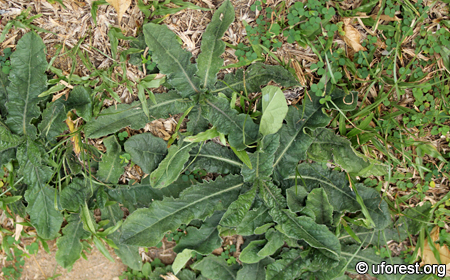Elephantopus scaber L.
| Etymology | Genus | Elephant's foot |
|---|---|---|
| Species | Rough; referring to the texture of the plant | |
| Family | Asteraceae | |
| Synonyms | Elephantopus carolinensis G.Mey., Elephantopus sordidus Salisb. | |
| Common Names | Elephant's Foot | |
| Status | Undetermined | |
| Form | Herb | |
| Native Distribution | Tropical America, Africa, Asia, Australia | |
Diagnostics:
Elephantopus scaber is a common weed among lawns. It has dark green elongated leaves arranged in a rosette at the base. The leaf margins are uneven or serrated. A flowering stem extends out where it ends with 3 bracts holding the purple flowers.
Interesting Facts:
The Elephant's Foot's weediness was already apparent in the early days of Singapore. Henry James Murton, the first superintendent of Botanic Gardens, remarked that Singapore's "good timber trees have almost entirely disappeared, and we have large tracts of land at present overrun by lalang grass and Elephantopus scaber" (Murton, 1876).
Its leaves and roots are widely used traditionally as used as a tonic, for the expulsion of intestinal worms, diuretic, febrifuge, and as a cough remedy (Globinmed, 2010).

Flowering stalks of the Elephant's Foot emerging from the lawn.

Form of the Elephant's Foot.

Leaves are arranged in a rosette.

Close-up of the flowers subtended by 3 bracts.
References
Globinmed. (2010) Elephantopus scaber. Global Information Hub on Integrated Science, Institute of Medical Research, Ministry of Health, Malaysia. http://www.globinmed.com. Accessed on 19-Apr-2014.
Murton HJ (1876) Report on Government Botanic Gardens. Singapore Botanic Gardens Library. p 2. 9 March 1976.
Author: Siyang
Posted: 2014-04-19 / Modified: 2025-07-05